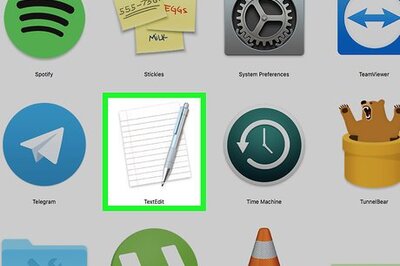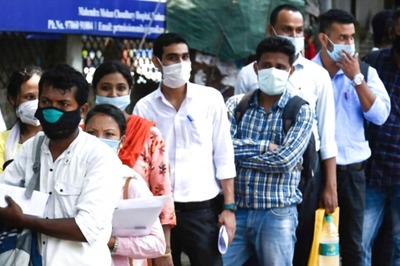
views
Name: Manish Sabharwal
Profile: Co-founder and Chairman, TeamLease
Age: 41
Why He Won For trying to fix India’s people supply chain. And helping shape policy to bridge the gap between education and employability.
At TeamLease, we hire somebody every five minutes, but we hire only 5 percent of the kids who come to us. It means rejecting 30,000 kids. It’s a bad business; it breaks our hearts. The issue, in fact, is bigger. Let’s ask what keeps India in poverty? We believe, it’s lack of access to three Es — employment, employability and education. We were in the employment business, but we needed to get into employability and education. We have a chance now, a unique moment in time. There’s this unique window in the next 10 years to be able to scale up to a million employees and to demonstrate that it is possible to manufacture your own employees for jobs.
Internally, there were people who said “You are trying to act like Henry Ford”. As you know, Ford wanted to make a car. So, he bought Firestone to make the tyres for the cars and then he bought a plantation in Brazil to produce rubber for the tyres. So, how far back do you go? Is it megalomaniac to say that you can manufacture your employees? But, I think we have no choice.
Sometime back, I was in Rajasthan, among some 800 guys looking for a job, and I was the only one wearing a suit for hundreds of kilometres. I can guarantee those kids would have got a job if they were in Bangalore. But they were born in Barmer and Jhunjhunu. They were raw. That’s when Ashok [Reddy, co-founder and MD] and I realised, if only we could do that, it’s a market solution to employment. I’m not doing anyone a favour here. Everybody is better off. The kid is better off, the employer is better off and I’m better off.
To address employability, we took over [vocational training institute] IIJT. The path was not easy. When we started, centre managers viewed employers and job fairs as an interruption to their business. We got rid of 30 percent of our centres and 30 percent of our centre managers after we took over.
But most people were willing to be led if there was a clear model before them. Ashok and I told them, “Look, what you are training for is not what employers want.” We brought employers to talk to them, we brought employers on the academic council. In a change process, the messenger is more important than the process. We had a track record of success. The credibility that TeamLease brought with it made the change process easier. Now, centre managers have embraced job fairs as a wonderful way to signal to students that we are an employer-centric company.
The other hurdle was the belief that learning meant sitting in a classroom, in front of a trainer. But, we don’t have enough of them. Sometime back, I met some of our trainers in Kanpur and I thought, “Man, I bought this company to have students like you. You should be sitting in the class!” But the reality is, how do you find trainers in small cities? You have to use technology. We use multiple platforms — campuses, centres, cloud, satellite and on-the-job training. There is resistance. [But] I think in the long run we have no choice.
With TeamLease University, our biggest challenge is the regulatory acceptance of the role of a for-profit sector in higher education and vocational training. I don’t think we’ve got there yet. The only reason we have a university in Gujarat is that it’s a Section 25 [a non-profit] organisation.
I have to convince the system that jobs and employability are very closely related to education. You can’t have good higher education without employability and you can’t have employment without employability. The country needs all the three. At TeamLease, we straddle all three. Over the next 10 years, demand is going to outstrip the quality of supply, and we want to fix the people supply chain. What’s happening in India happens only once in a lifetime of a country. We believe we can become a lighthouse that demonstrates what is possible.
(As told to NS Ramnath & Nilofer D’Souza)
‘He has the ability to align people to the vision’
Ashok Reddy, co-founder and MD, TeamLease
I know Manish from my college days. We both went to Shri Ram College of Commerce, New Delhi, and later founded India Life [along with Mohit Gupta, Manish’s schoolmate]. Even during his college days, Manish was inquisitive, intelligent and willing to see things differently. He has the capability to both look at the larger picture and align people towards that.
Many of these qualities came to help when we decided to get into training. Our getting into training, and buying IIJT was basically about backward integration. The dispersed nature of business entailed operating in multiple locations, ensuring the same quality across different centres. All these demanded a different mindset, different learning and different set of challenges.
We were clear that we wanted to build a company that was profitable in the long run and also good for the country. We wanted to build an organisation that was entrepreneurial, ready to experiment — test the hypothesis, and if something is right, scale it up, and if it’s not, discard it and move on. The key here is to put people in place, empower them and let them share our vision.
Manish’s role was in communicating the bigger vision of the organisation. He is clear about the review and monitoring mechanism that needs to exist and also the need to take action and move forward rather than wait for data points. He is very good at doing that, he is a good motivator.
Manish is also playing a big role in public policy. There is no immediate impact. Still, it’s our conscious strategy to involve ourselves in this. People have asked why, and I tell them this story. A man had two wives, and one day he passed away. One of his wives was distraught, she cried hard, prayed hard. The other wife didn’t seem to be bothered at all. When someone asked her if she didn’t feel the pain, she replied, “When her husband comes back to life, mine will too.” The problem is, not all of us can afford to do that. Someone has to take it up.




















Comments
0 comment